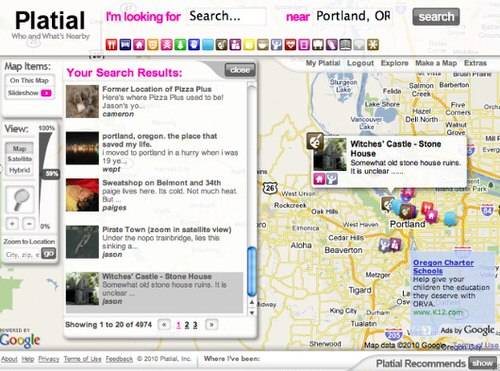It’s not every day that a business shuts down but declares itself a success in helping kick off an unstoppable movement to change the world.

Community mapping service Platial announced this week that it is turning off its servers and asking users to move their content onto the servers of other providers. Just short of 5 years old, Platial raised some venture capital, bought other small companies and made a name for itself, but in the end wasn’t able to build a business. Co-founder Di-Ann Eisnor defiantly says that Platial changed the world anyway. Cartography used to be an elite practice of drawing borders around resources and power. Platial helped transform it into an accessible practice for millions of people to share how they have experienced the world around them.

In the late 90’s Di-Ann Eisnor was the founder and CEO of Eisnor Inc., an “alternative” marketing agency that helped companies launch and grew to 60 employees with $15 million in annual revenue. In 2000 she sold that company to Omnicon.
Then she traveled the world and did independent marketing work for large companies and small cultural institutions.
In 2004, Eisnor co-founded Platial in Portland, Oregon with Jake Olsen and Jason Wilson. The company’s pre-launch website described the project as “a rapidly developing application and community pivoting on the anchors of user annotation, layerability, collaborative mapping, social networking and real world publishing.” The three founders said they were taking advice from people like Clay Shirky, Anselm Hook and Arturo Duran. In addition to an email list you could sign up to learn when the product was available, the Platial website was filled with a tag cloud linking to Delicious pages of community bookmarks on topics like folksonomy, groupmaps and where2.0.
Platial put itself right in the middle of those heady times. We were all going to describe, categorize and display our world on our terms. Blogger had just been bought by Google the year before and WordPress had just launched. Delicious and Flickr had just gone live and would be acquired by Yahoo a year after Platial’s founding.
These were revolutionary tools, like tiny virtual Gutenberg dynamos, the number of publishers and amount of content and data published exploded. People were telling their stories through blog posts, they were posting their photos and using Platial and Frappr, which Platial later acquired, they were making maps.
They made maps about the history of Palo Alto, California. About the reconstruction of New Orleans. About the companies that make London, England the arms trade capital of the world. In the end Platial held 5 million user-created maps.
For perspective, the field of cartography began roughly 1500 years ago. Only 1,000 European maps of the world are known to still exist from the years 500 through 1600. Platial’s properties saw users make that many maps every eight hours, on average.
Now people are making maps all over the web, including on Google’s MyMaps service. Eisnor says Platial was particularly innovative among map making services. But it wasn’t able to build a sustainable business.
Eisnor says the business model was always local advertising but local advertising didn’t arrive in time. The company’s 500,000 map widgets embedded in blogs around the web never brought in more than a pittance in revenues. Delivering those widgets cost thousands of dollars per month. The company had a half a million iPhone app users to serve after being featured by Apple. The small staff worked without pay for the last 18 months. Several acquisition conversations fell through.
This weekend co-founder Jason Wilson put up a post on the company blog titled Geographic Euthanasia: The End of Platial As We Know It.
Eisnor says she has very mixed feelings about the elephant in the middle of the room, Google. “Without them we would be going out of business and there would be no where to send the data.”

“They started MyMaps two years after us. They executed really well. We didn’t pull it off… In terms of telling stories, I don’t know that there’s a business in [user created maps]. Google’s [map making effort] doesn’t have to be sustainable, it has an infinite amount of money. But Google is allowing people to tell their stories and is not in danger of having to shut down peoples’ maps. Plus they are very active in places like Africa where it’s even more important and hard to get people to contribute.
“Never mind that we used their maps. We took the movement further than they could have.”
Eisnor works at Waze now, a company that’s building real time street maps through shared driving data. It’s not the same, it’s an attempt to disrupt an established market instead of an effort to create a new user behavior, Eisnor says. Neither are the numerous location based check-in networks the same as what Platial was doing, they aren’t really about telling a story.
The market’s enthusiasm for user generated mapping may be contracting after a few years of initial excitement, but make no mistake: there is a big new way for people to publish the way we see the world now. That’s important and it will never disappear.
Platial says it was all about “AutoBioGeography, Place Memory, Location Awareness.” Those are important concepts that were changed by this ambitious little startup, whether it survived as a business or not.
You can stay abreast of future projects the Platial team develops on the side on its Twitter account and keep up with the work and thoughts of Di-Ann Eisnor, Jason Wilson and Jake Olsen.










